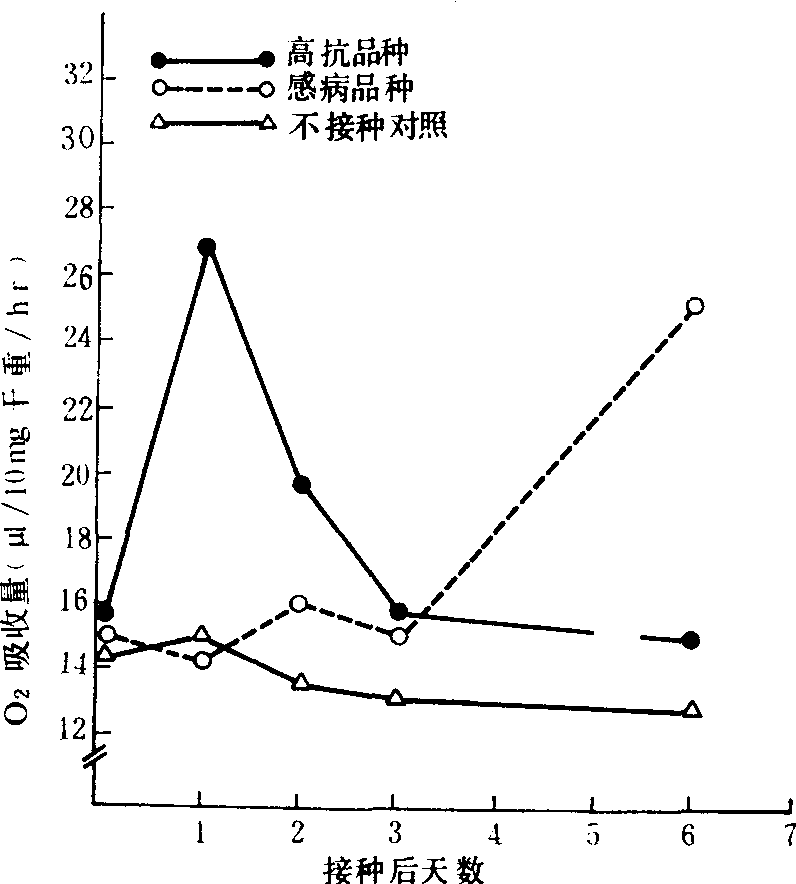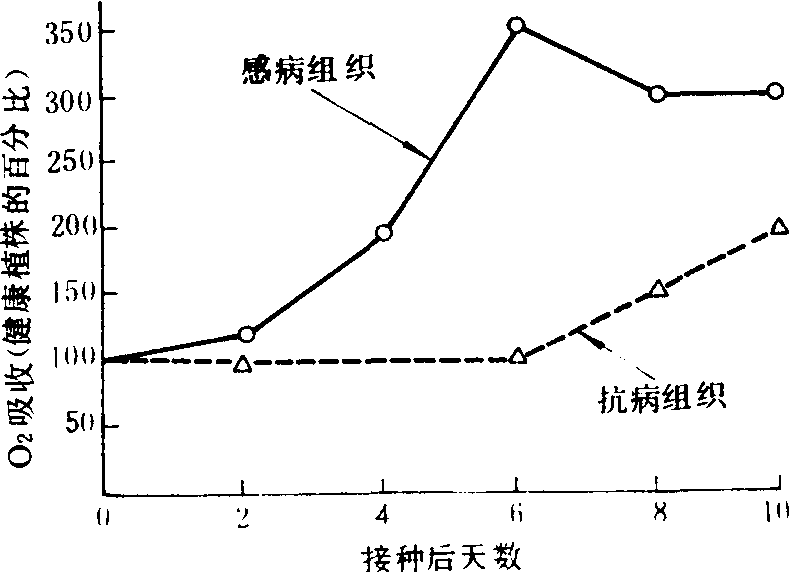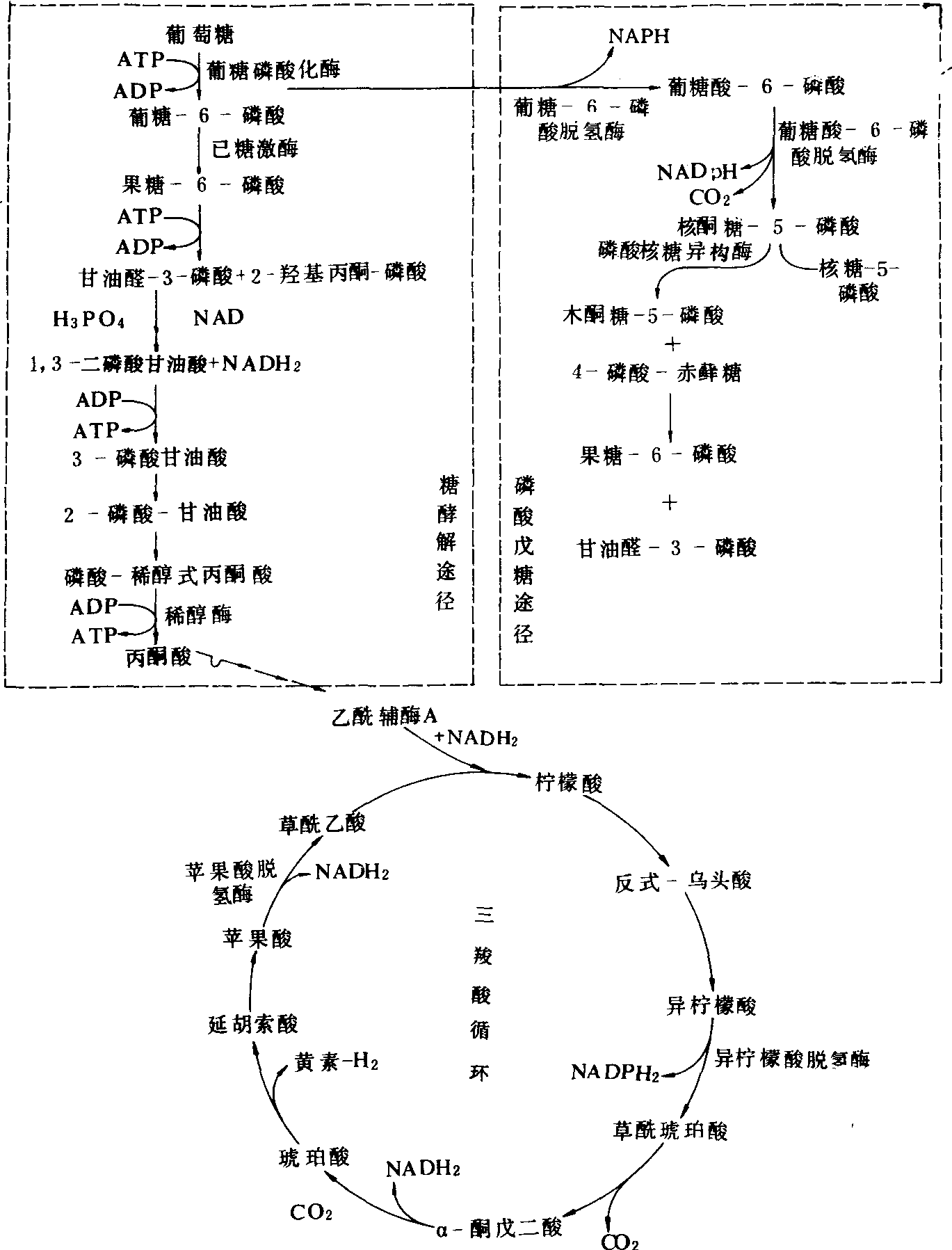病植物呼吸作用respiration of diseased plants
植物受病原物侵染过程中呼吸速率、呼吸途径和电子传递过程发生不同程度的变化。
呼吸速率变化 病植物呼吸速率一般比健康植物高,不同病原物—寄主的组合,其病植物呼吸速率升高的时间和程度有差别,也有的病植物呼吸速率下降。
呼吸速率升高 植物受病原物侵染后的一种普遍反应。一般抗感品种呼吸率均升高,并有相似的动态变化趋势。感病品种也有呼吸速率迅速升高现象。
抗病品种呼吸速率迅速升高的现象常见于专性和兼性寄生真菌及某些细菌引起的病害。真菌侵染的病害一般在症状出现时植物呼吸速率急剧升高,随病菌子实体形成达到高峰,之后逐渐下降,但仍高于对照组织。如抗白粉病大麦品种受白粉病菌侵染后一天,O2吸收量比对照高1倍,而感病品种开始略低于对照,第6天时才显著升高(图1)。又如辣椒果实受斑点病菌侵染后抗病品种O2吸收立即增加,ATP也减少,感病品种直到接种后30小时才能测到。在许多病毒病中,抗病品种呼吸率在病害症状出现前或出现时升高。普通烟用烟草的抗病品种接种烟草花叶病毒后于病斑形成时(36小时)呼吸率显著升高,而感病品种增高不明显。

图1 抗感不同的大麦品种接种大麦白粉病菌(Erysiphe graminis f. sp. hordei)后叶片的呼吸速率
(引自V. Smedegaard-Petersen和O.Stlen,1981)
感病品种呼吸速率迅速升高的现象如烟草青枯病中,抗病品种Coker139的组织摄氧量在侵染后第8天上升为对照的150%,而感病品种Bottom Special第2天即开始升高,第6天升至对照的350%(图2)。
呼吸速率降低 一般发现于感病植物中。如土耳其烟草受烟草花叶病毒侵染后呼吸速率下降。也有认为感病植物呼吸率升高与其计算方法有关。如感病烟草品种受烟草花叶病毒侵染后,若以单位鲜重CO2释放量计算,则病组织呼吸速率显著高于健康组织。由于病毒侵染使病组织水分丧失,因此应以干重计算更为合理,这样计算病组织呼吸率比健康组织略低。番茄受烟草花叶病毒奥古巴株系侵染后,以组织鲜重计算,则矮化病茎的呼吸速率高于健康组织; 若以节间耗氧量计算,病节间(与健康节间的细胞数目相等)呼吸速率显著低于对照。

图2 烟草抗感青枯病品种离体基段接种后的摄氧量
(引自E.C.Maine,1960)
呼吸速率升高机制 病组织中呼吸速率升高是寄主本身的作用或病原物生长繁殖引起的,或二者共同作用所致。植物本身呼吸作用增强的机制主要是氧化磷酸化作用解偶联、生物合成加强、细胞膜透性改变等。
氧化磷酸化作用解偶联碳水化合物只氧化,而不形成ATP,导致ADP和无机磷酸增多,通过植物自身的调控机制而使呼吸增强。如小麦抗锈品种在整个病程中及感病品种的病程后期呼吸速率升高,组织中无机磷酸增多,ATP减少,对氧化磷酸化解偶联剂2,4-二硝基酚变得不敏感。
生物合成加强 植物对病原物的主动反应过程中木栓质、愈伤组织、胼胝质等的形成,植物保卫素等次生抗菌物质的合成,均需要呼吸作用提供各种碳架,同时大量消耗ATP、NADPH等高能化合物,导致ADP浓度增加,从而导致呼吸作用增强。
细胞膜透性改变 病原物产生的毒素、酶及激发子等,作用于植物细胞后使细胞透性增强,酶与底物的分室效应丧失,呼吸增强。如HMT毒素作用于感病玉米后线粒体膜透性增大,NAD易于透过,氧化作用增强。
呼吸途径变化 伴随呼吸速率的升高,病植物中不同呼吸途径发生特定的变化。
磷酸戊糖途径激活 是大多数病害中呼吸作用特征。有以下几方面证据:❶植物无氧和有氧呼吸的CO2比值小于理论值0.33。如红花下胚轴受红花柄锈菌侵染后二者比值为0.23。
❷呼吸商小于1。如根癌土壤杆菌引起的甜菜块茎肿瘤组织的呼吸商为0.92,表明组织中脂类的β-氧化作用减弱。
❸C6/C1值变小。在磷酸戊糖途径中,葡萄糖的C1碳原子主要以CO2形式释放,因而C6/C1将小于1。如红花锈病、蚕豆锈病、小麦锈病等病组织的C6/C1均显著下降。大豆下胚轴受立枯丝核菌侵染后含菌丝病斑组织及不含菌丝的周围组织中C6/C1均下降,随病害发展C6/C1值升高,但仍低于对照组织。在大麦白粉病、小麦锈病和菜豆锈病中,C6/C1值减小的动态与呼吸作用升高相一致。
❹磷酸戊糖途径有关酶活性增强。此途径糖代谢参与的酶与其它途径不同。如根癌土壤杆菌侵染甜菜块根组织中葡糖-6-磷酸脱氢酶、葡糖酸-6-磷酸脱氢酶和磷酸核糖异构酶活性比健康组织高2~3倍; 野火病菌(Pseudomonas tabaci)侵染的烟草叶片中晕圈组织的葡糖-6-磷酸脱氢酶活性比正常组织高2.5倍; 烟草花叶病毒侵染的三生烟中磷酸戊糖途径占总呼吸活性的比重提高,此途径的前2种酶活性比健组织强,而糖酵解途径的酶葡糖-磷酸化酶、己糖激酶和磷酸己糖异构酶活性无变化。

图3 植物呼吸途径及有关酶类示意图
糖酵解和三羧酸循环活性减弱 主要对有关酶抑制剂的反应迟钝和有关酶的活性减弱。
对酶抑制剂反应迟钝 用糖酵解和三羧酸循环特殊酶的抑制剂处理病组织,病组织的呼吸性质改变。如F-和CN-是糖酵解途径重要酶——烯醇化酶的抑制剂,红花下胚轴健康组织受NaF抑制率为50%,而受锈菌侵染后抑制率仅33%,表明病组织糖酵解作用减弱。丙二酸是三羧酸循环酶——琥珀酸脱氢酶的抑制剂,小麦锈病、芸薹属霜霉病组织中呼吸作用受丙二酸的抑制作用比健康组织显著下降,表明三羧酸循环活性减弱。
酶活性减弱 如根癌土壤杆菌引起的甜菜块根肿瘤组织中磷酸己糖异构酶、3-磷酸-甘油酸激酶和磷酸果糖激酶活性下降; 马铃薯L病毒等侵染马铃薯后与糖酵解途径有关的几种酶活性也下降。又如白肋烟受烟草花叶病毒侵染后虽然乌头酸酶和异柠檬酸脱氢酶活性升高,但苹果酸脱氢酶无变化; 根癌土壤杆菌引起的曼陀罗和胡萝卜肿瘤组织中与三羧酸循环有关的酶活性减弱。辅酶A的积累也证明三羧酸循环活性减弱。
磷酸戊糖途径激活机制 与植物防卫基因的表达及产物合成有关。苯丙烷类化合物及其衍生物如木质素、类黄酮、类异黄酮、香豆素、羟基肉桂酸酯等,它们直接或间接与植物抗病性有关,这些物质的前体——莽草酸是磷酸戊糖途径的中间产物——4-磷酸赤藓糖合成的。此外,磷酸戊糖途径产生的核糖为植物基因转录提供核糖骨架(图3)。
巴斯德效应丧失 植物被真菌、细菌侵染后呼吸速率降低,进一步导致呼吸速率升高。如根癌土壤杆菌引起甜菜根瘤组织、红花锈病组织的巴斯德效应(0.26)比健组织(0.62)显著下降。

图4 电子传递过程和氧化磷酸化作用示意图
电子传递和氧化磷酸化作用变化 糖酵解三羧酸循环产生的电子和氢,经一系列传递过程到分子氧,产生水,同时发生磷酸化作用产生ATP(图4)。病植物的这一过程发生不同的变化。
细胞色素系统加强 在专性或兼性寄生菌引起的感病反应的早期阶段,电子传递系统仍以细胞色素系统为主,但其活性增强。如红花下胚轴受锈菌侵染后,组织对细胞色素a3抑制剂叠氮化物或CO的敏感性提高,而光可逆转这种抑制作用,说明病组织电子传递系统活性增强。
细胞色素系统抑制 在抗病反应的全过程和感病反应的后期阶段,病植物电子传递的其它氧化酶系统被激活,细胞色素系统受抑制,电子传递从辅酶Q发生短路而传递给其它电子受体,这一过程中不发生磷酸化作用,组织中ADP/ATP值升高,主要用于氧化磷酸戊糖途径产生的NADPH。
抗坏血酸氧化酶系统 小麦锈病、稻瘟病等病害中,其电子传递过程是:
NADPH→谷光甘肽→抗坏血酸还原酶→抗坏血酸氧化酶→O2
多酚氧化酶系统 镰刀菌、疫霉菌等引起的病害中,其电子传递过程是:
NADPH→谷光甘肽→抗坏血酸→醌→多酚氧化酶→O2
其它氧化酶 主要有羟基乙酸氧化酶、过氧化物酶、过氧化氢酶等。如根癌土壤杆菌引起番茄肿瘤组织中过氧化氢酶增加160%,过氧化物酶增加120%。马铃薯晚疫病和甜菜根肿瘤中的末端氧化酶从细胞色素氧化酶变成多酚氧化酶和抗坏血酸氧化酶。
呼吸改变的意义 植物受病原物侵染后,无论抗病或感病反应呼吸作用均发生变化。呼吸改变在抗病反应和感病反应中所起的作用不同。
抗病反应作用 有二层含义: ❶在抗病品种中,早期呼吸作用变化为植物发生抗病反应提供必须的能量和碳架。植物从合成小分子的植物保卫素如甾类、萜类和黄酮类物质,大分子的蛋白质、多糖和核酸等直到形成有组织结构的物理屏障,如侵填体、愈伤组织等均需要呼吸作用提供物质基础。马铃薯块茎受胡萝卜软腐欧文氏菌(软腐病菌)侵染后产生1分子日齐素所需的碳架来自9分子的丙酮酸产生乙酰辅酶A合成1分子甲羟戊酸,再要3分子ATP将甲羟戊酸转变成倍半萜,由糖酵解提供丙酮酸和ATP时共需4.5个葡萄糖分子。
❷感病品种对病原物侵染具有一定的基础抗性,虽然从反应的速度和强度上低于抗病品种,但反应的性质是类似的。
感病反应作用 感病品种受专性寄生病菌侵染后,通过改变呼吸作用为病原物的生长、繁殖提供大量的营养等条件从而建立寄生关系,同时,感病植物本身的不正常生长,代谢产物的积累和运转以及原生质流的增强等均需要能量,因此呼吸作用增强。